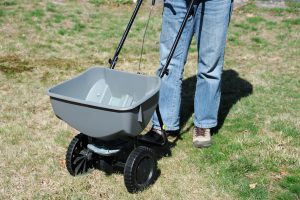As I wait in line at the garden center to pay for my new spring plant purchase, I see big stacks of “weed & feed” and other lawn fertilizers conveniently located to grab and go on the way out the door. The images of lush green grass and guarantees of a thicker lawn plus many months of weed-free bliss are hard to resist. I’m itching for that spring flush of green and the smell of fresh cut grass. It’s tempting to throw a couple bags in my cart since my yard looks patchy and brown right now. If I throw down some granules now, it’ll surely help speed up the process, right? Turns out, the answer is NO! I did the research, so you don’t make the same mistake I almost made (and so many homeowners in Florida do each year)
Here’s what I learned:

What does “weed & feed” even mean, and should I use it?
“Weed & feed” is a combination product containing herbicide and fertilizer in one marketed to make weed management and feeding the lawn easy. Weed=herbicide and feed=fertilizer. These products aim to kill weeds before they emerge while conveniently feeding the lawn at the same time. BUT there’s a CATCH! To be effective, in N Florida the first application of a pre-emergent herbicide (like those contained in weed & feed products) should be applied in late February or early March when day temperatures reach 65 F to 75 F for four or five consecutive days. However, a fertilizer application this early in the year could be ineffective or even harmful to the lawn. At the time a pre-emergent herbicide should be applied, the lawn is generally still dormant, and roots are not actively growing enough to take up much fertilizer. This extra fertilizer runs off, wasting your money and leading to groundwater pollution.

When should I fertilize my lawn in N Florida?
Fertilizer should be applied ONLY when plants are actively growing. In general, lawns in our area should be first fertilized in April, but there is no set day on the calendar when it is recommended to fertilize because it really depends on the weather. A good rule of thumb is to wait until after you’ve had to mow your grass twice. Growing grass indicates warm enough weather for your lawn to completely come out of dormancy, meaning it will be able to take up and use the fertilizer that you put down. The last fertilization should take place no later than mid September which is when the grass begins to go dormant for the cooler months.
What if my lawn is brand new?
Wait at least 30-60 days before adding any fertilizer to a newly planted lawn. This allows time for roots to become established enough that they can take up and use the fertilizer; thus reducing the risk of nutrient leaching.
Be Florida-Friendly and leave the “weed & feed” at the store!
To sum up my findings, I learned it is important to understand the timing and proper application of herbicides as well as fertilizers to ensure the health and growth of your lawn. Applying these products at the right time can make a significant difference in the effectiveness and overall well-being of your grass, preventing waste and pollution. Be Florida-Friendly and leave the “weed & feed” at the store! If you have more questions about fertilizing your home lawn a helpful guide can be found here.
Note: All images and contents are the property of UF/IFAS.’



